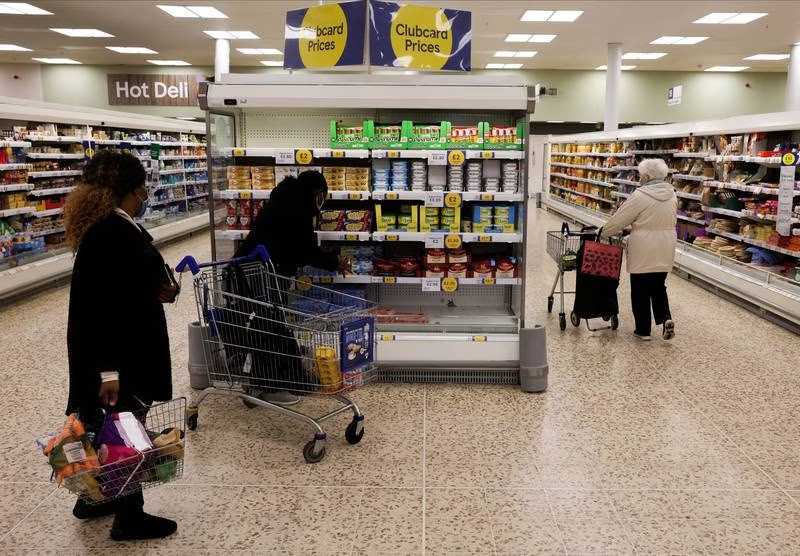Why consumer-goods manufacturers are finding it difficult to raise prices further

Inflation-pinched consumers are tired of paying more for food, soap and other branded goods, with European shoppers leading the rebellion. Companies ranging from Ben & Jerry's owner Unilever to Lysol maker Reckitt Benckiser Group have reported declining sales volumes in recent months, with many consumers turning to cheaper, private-label goods in an attempt to ease a severe cost-of-living crisis.
The problem is most severe in Europe, where supermarket chains are pushing back against raising prices. “Europeans are under stress. There is an issue with pricing power,” said Reckitt chief executive Nicandro Durante.
Reckitt’s health-related products are often typically recession-proof because they are less frequent purchases and can be considered essential by shoppers. Yet the British company this week reported a 5.8 percent drop in sales volume in the final quarter in a decline that can be only partially explained by the group selling less Lysol disinfectant since the pandemic.
The story at Unilever is a similar one. When Hellmann’s mayonnaise maker raised prices in Europe by 8.3 percent in 2022, the volume of products Unilever sold there fell by 3.9 percent.
An even bigger price increase in North America, however, dented volumes by only half as much. Nestle, Danone and Colgate-Palmolive have flagged similar issues, with weaker consumption in Europe.
“Really, it is quite a step change,” Unilever chief financial officer Graeme Pitkethly said of the shift from deflation to inflation in Europe on a recent call with analysts. “We’ve recently seen share gains by private labels in Europe in most categories.”
Makers of household and personal-care products seem more cautious about the runway left for further price increases than their counterparts selling food and beverages, Barclays analysts Lauren Lieberman and Andrew Lazar wrote in a note after the Consumer Analyst Group of New York conference last week.
The waning pricing power of consumer goods manufacturers contrasts with car makers and airlines, which have been able to push prices up due to limited supply and pent-up demand.
Chief executives of companies like Reckitt and Nestle think inflation has peaked. Yet agricultural supply glitches, the ongoing geopolitical fallout from the Ukraine war and a stronger-than-expected rebound in China could cause further shocks in input costs, such as logistics or raw materials.
Last week, the US said it would impose a 200 percent duty on Russian aluminum imports, a move likely to increase prices overall and costs, particularly for drinks makers such as Coca-Cola. Outgoing Unilever chief executive Alan Jope in January forecast a sudden surge in consumption in China, the world’s second-biggest economy, as it abandoned its zero-Covid policies more quickly than anyone foresaw.
With the makers of toothpaste and mayonnaise facing significant erosion to market share if they keep ramping up prices, finding cost efficiencies becomes ever more important.
“As you might expect as the inflationary cycle wears on, each new pricing decision becomes more difficult,” said Procter & Gamble's chief financial officer Andre Schulten. “We do everything we can to offset cost increases with our products work to minimize the need for pricing.”
Structural differences in how price rises are negotiated in Europe and the US could have played a role in weaker volumes in the trading bloc. In Europe, suppliers typically negotiate prices with retailers annually while in the US these conversations happen more regularly throughout the year.
Danone deputy chief executive Juergen Esser said the yogurt maker suffered volume hits in Europe from costs rising faster than price rises could be negotiated. The company stopped supplying some products because prices could not be agreed on in time.
Talks can also backfire. Heinz temporarily stopped supplying Britain’s largest supermarket, Tesco, with products over a pricing row.
There are some categories that enjoy more resilient demand — notably the pet-care units of Nestle and Colgate, which managed to increase both pricing and unit sales. Yet gross margins at most consumer-goods makers are below 2021 levels, making it likely that they will want to recover some of the profitability they have lost.
Misjudging the plans of competitors also carries heavy penalties in the fiercely contested sector, according to Richard Webster, head of global consumer products practice at consulting firm Bain & Company. “There’s a competitive dynamic between the consumer products companies, because if I raise the price, but my competitor doesn’t, there can be quite a big market share change,” he said.
Tags :
Previous Story
- US inflation falls again to ease pressure on...
- US hiring remains resilient as Federal Reserve grapples...
- Turkey inflation slows the most since 1995 ahead...
- Lebanon inflation rate increases 189% in first 11...
- UK inflation falls from 41-year high as fuel...
- Payrolls and wages blow past expectations, flying in...
- Asian shares mixed as investors eye Tokyo inflation...
- Inflation expectations rebounded in October on record-high jump...